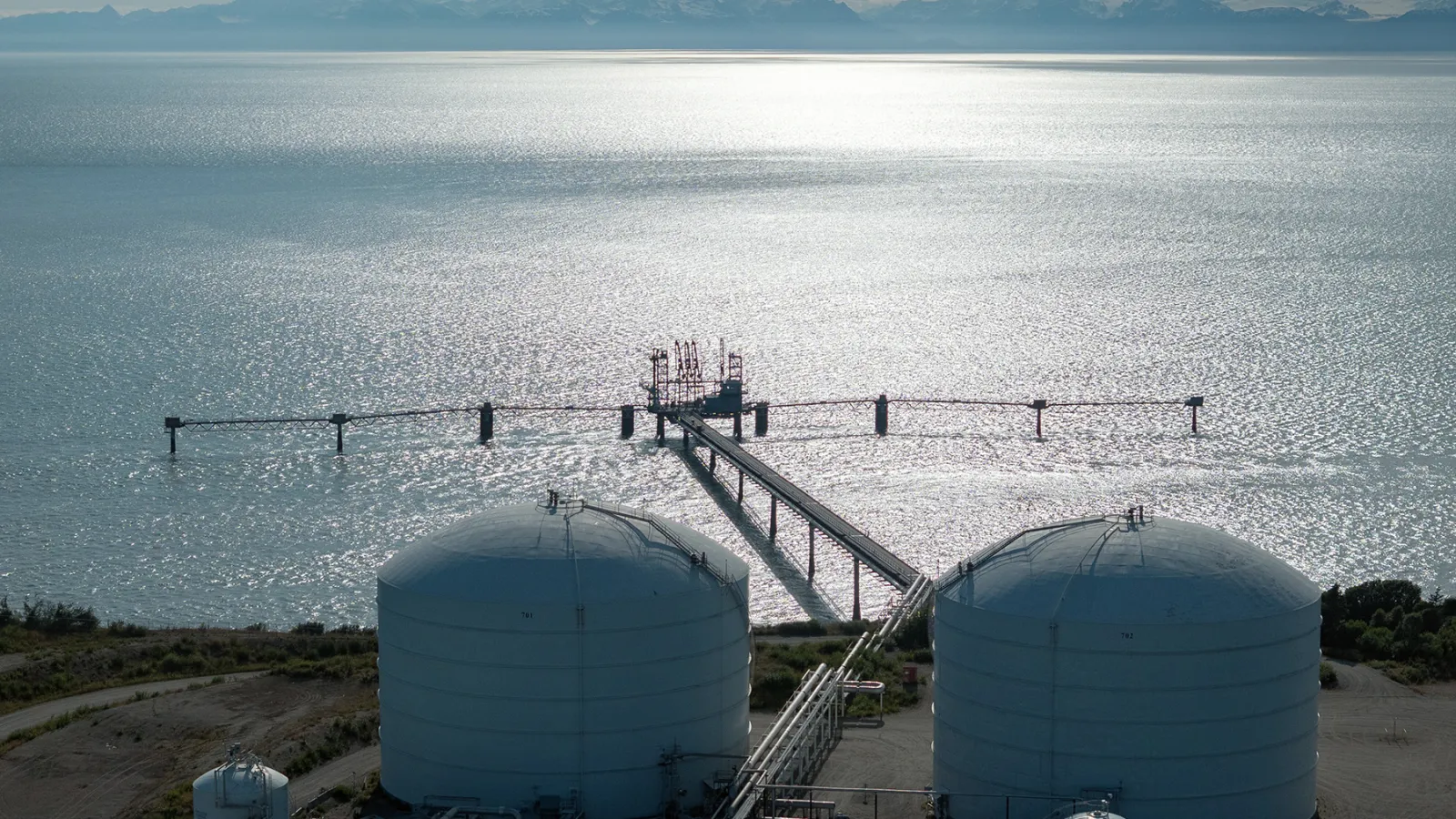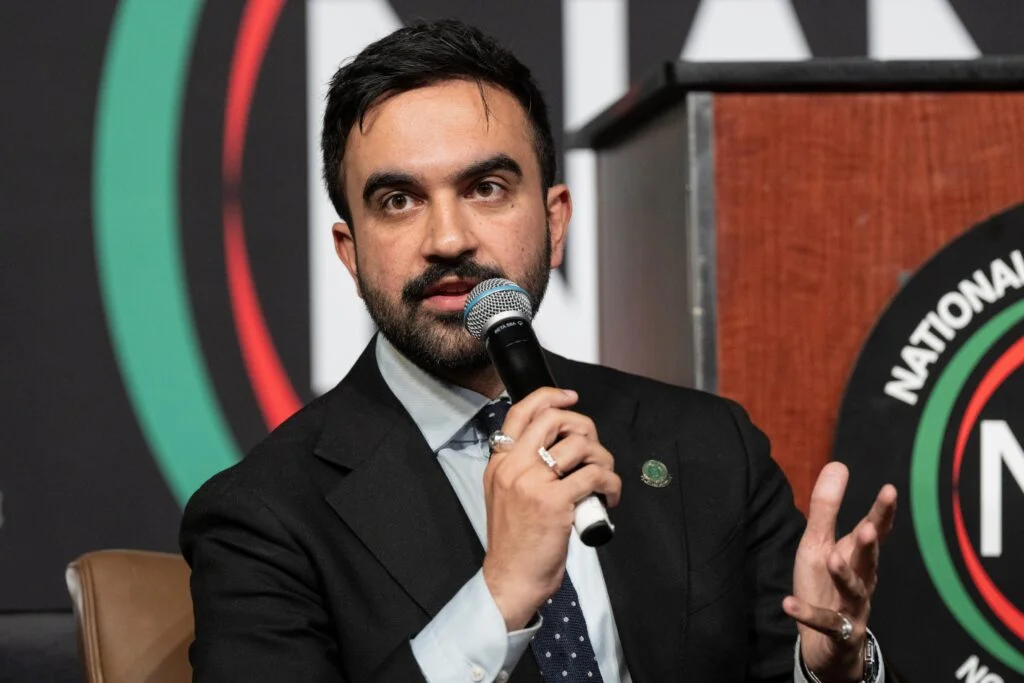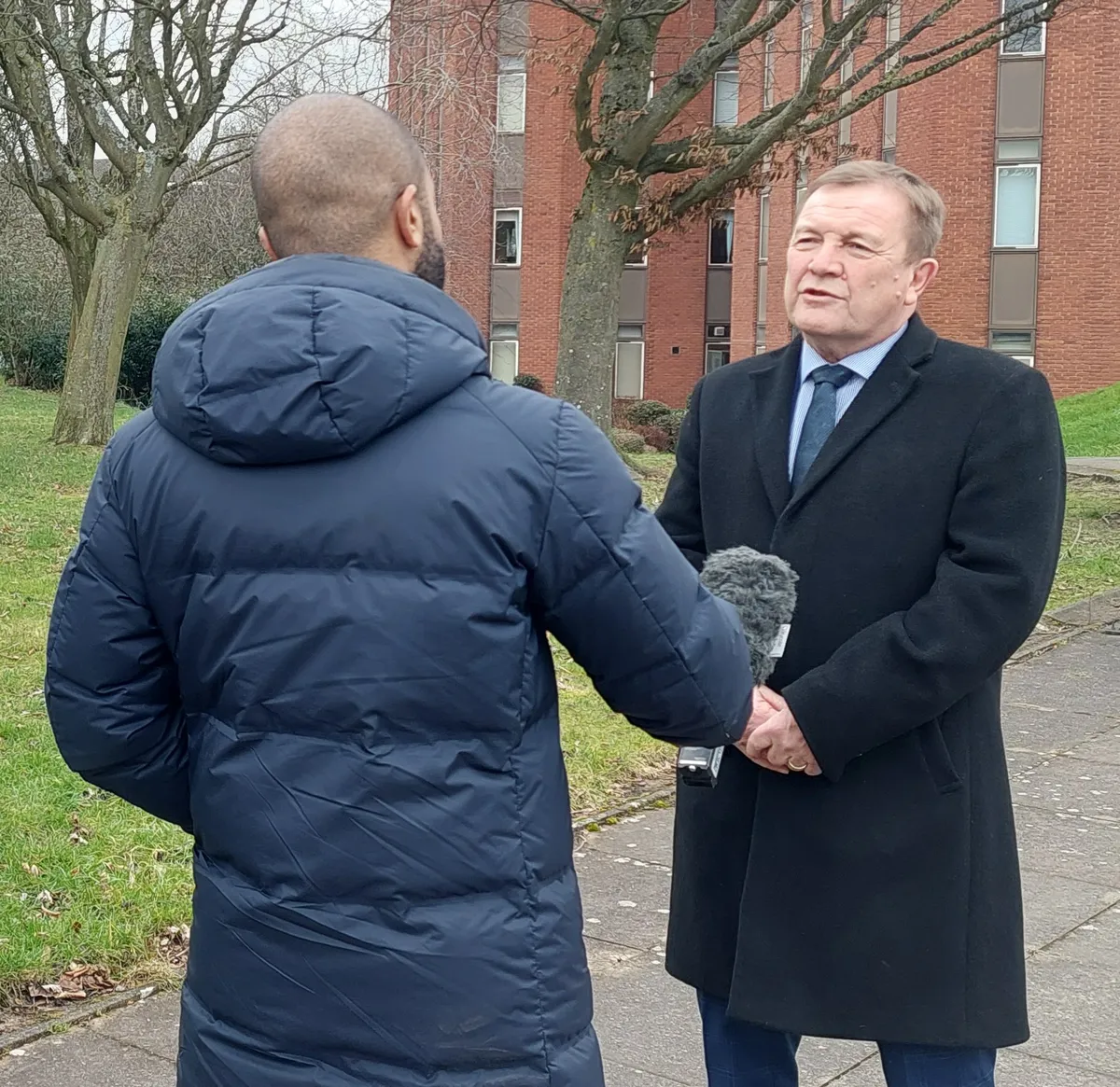
In a xenophobic, hate-filled speech laden with lies and disinformation, President Donald Trump declared before the United Nations General Assembly on Tuesday that climate change is “the greatest con job ever perpetrated on the world,” and railed against all forms of green energy. It was more than just a rant; it is Trump’s policy.
Trump has set his sights on Alaska as a test case for his disastrous “National Energy Dominance” agenda. He wants to double oil production in the state, open up vast new tracts of land to exploitation, kneecap renewable energy, and push construction of what would be one of the largest and most expensive fossil fuel infrastructure projects in the nation. The project includes a massive 800-mile-long gas pipeline stretching from one end of Alaska to the other and a mammoth new export facility to ship gas out of the U.S. to Asia, with an estimated total price tag of over $70 billion.
Last month, I met people across Alaska organizing to resist Trump’s plans. They are pushing back against an agenda they see as catastrophically harmful to their pocketbooks, their way of life, and even their existence. They characterize Trump’s fossil-fueled ambitions as more of a retrograde political ploy than a genuine effort to benefit the state or the nation. Organizing against Trump’s energy agenda has strengthened ties between people often viewed as political adversaries, they explain, providing a sense of community and purpose despite the president’s best efforts to divide the nation.
“No one is throwing up their hands and saying, ‘Well, he’s won,’” Elisabeth Dabney, longtime executive director of the Northern Center in Fairbanks, tells me. “There is hope in being an Alaskan in this moment and seeing that there is solidarity, there is gumption to not give up, and there is strategy. It’s very powerful.”
Opening Alaska’s Oil and Gas Veins
On the first day of his second term in office, Trump signed an expansive executive order, “Unleashing Alaska’s Extraordinary Resource Potential.” Two hundred and nineteen executive orders have followed, but Alaska remains the one and only state to receive such unique and unprecedented attention.
Editor’s picks
The order seeks to open Alaska’s oil and gas veins to extraction, proposing massive expansions of operations in a state that is already being pummeled by the impacts of the burning of fossil fuels driving the climate crisis, with devastating harms to the local economy, environment, and the survival of its residents.
On August 13, just two days before Trump hosted Russian President Vladimir Putin in Anchorage for a summit that did little to advance peace in Ukraine but did further both presidents’ commitment to fossil-fueled autocracy, residents of Alaska’s capital city of Juneau were evacuating in advance of historic flooding from nearby melting glaciers.
After reporting on the summit, I boarded the Taylor Skiff, bound for another Alaskan glacier disappearing because of global warming. The small boat was made by hand as a “Covid project” by Andy Moderow, a dedicated Swifty who christened his boat accordingly. The Alaska native is the senior director of policy at the Alaska Wilderness League, working with allies across the state to halt Trump’s agenda.
Our destination lay east of Anchorage, across the waters off of the small community of Whittier, and up a short hike to the Lawrence Glacier. Moderow has been visiting the site for years for recreation and now to track the stunning blue and white glacier’s painful retreat. He describes watching the glacier “deflate like a balloon.” The less glacier ice there is, the less water there is for human use.
Related Content
We’re joined by glaciologist and geophysicist Emily Baker, who explains that it is normal for glaciers to melt, but there should be enough cold and snow to replenish it “were we in a stable climate, but we’re not in a stable climate it turns out! Who knew?! It turns out, everyone knew.”
Baker recently left her dream job of nine years working at the U.S. Geological Survey studying glaciers in Alaska — a victim of Elon Musk’s so-called Department of Government Efficiency, or DOGE.
“There are people who think we can continue to have a free lunch,” Moderow says, extracting, producing, and burning fossil fuels without devastating harm. Baker adds, “They forget that we’re in an ecosystem we depend upon.”
Dagger to the Heart
Trump’s executive order directs federal agencies to open the Arctic National Wildlife Refuge to oil and gas drilling and expand drilling in the Western Arctic area designated as the National Petroleum Reserve-Alaska, undoing hard-fought victories won during President Joe Biden’s administration that protect native communities and sensitive areas from further harm.
At a press conference, Alaska’s Republican Governor Mike Dunleavy praised Trump while taking partial credit for drafting the executive order. His Department of Natural Resources commissioner, John Byole, said Trump finally ended Biden’s “war on Alaska” that sought to impose a “radical ideology” on the state, freeing Alaskans from “wine and cheese eating environmentalists in Seattle or San Francisco or some other terrible city that wants to impose their agenda on us.”
Since January, the Trump administration has moved swiftly to enforce the order with provisions included in the budget reconciliation bill, also known as Trump’s “Big Beautiful Bill,” and administrative actions. In June, Trump dispatched his secretaries of the Interior, Energy, and the Environment Protection Agency to Alaska to promote the projects and policy changes.
Kristen Moreland, executive director of the Gwich’in Steering Committee, tells me that the proposal to open the Arctic National Wildlife Refuge to oil and gas is “a dagger in the heart” of her entire native community.
“All of these horrible projects that we’ve been working to stop with thousands of Alaskans following tribal leadership to protect these lands” is now once again under attack by Trump, says Enei Begaye, executive director of Native Movement. Begaye is of the Diné and Tohono O’odham nations and founded the Anchorage-based nonprofit advocacy organization over 20 years ago with her partner, then chief of his Gwich’in tribe.
Trump’s order singles out the Alaska LNG Project, the proposed 800-mile pipeline and export plant, for special promotion. Liquified natural gas, or LNG, is gas processed into a liquid for transport. The order calls for “expedited permitting and leasing” and the “prioritization of the development” of Alaska’s liquified natural gas potential, “including the permitting of all necessary pipeline and export infrastructure related to the Alaska LNG Project.”
The U.S. is already the world’s largest exporter of liquified natural gas, with exports reaching an all-time high in August. This has reduced domestic supplies of gas and increased costs, driving a surge in home power bills across the nation. Trump’s rampage against renewable energy has already made wind and solar more difficult to use and expand, pushing electricity rates up even higher for American families.
“It’s outrageous insanity,” Begaye says of Trump’s LNG proposal. In an op-ed in the Anchorage Daily News, she joined leaders of several other Alaskan organizations to denounce the project, writing, “New pipelines and more fossil fuel extraction are not answers to any of the crises we face.”
Big Beautiful Twin
The first shipment of liquified natural gas left the United States in 1969 from Alaska’s Kenai Peninsula Borough port of Nikiski, delivering gas produced from offshore wells in Cook Inlet. The small plant shut down almost 40 years later in 2017, having helped virtually drain the inlet of gas.
Roughly two-thirds of Alaskans, some 450,000 people, live within the Kenai Peninsula and Cook Inlet region, most in Anchorage. The area remains largely dependent on Cook Inlet gas and faces a looming electricity crisis.
The vast majority of gas produced in Alaska feeds the fossil fuel industry, which uses it to produce more oil. The state also uses fossil fuels to export and import more fossil fuels. Alaska generates about 30 percent of its electricity from renewable energy, and during the Biden administration communities across Alaska received federal funding to support new renewable energy projects. Trump wants to move Alaskans and the nation in the opposite direction by aggressively clawing back federal funds and regulatory backing for renewables, while locking in long-term fossil fuel dependence
Administration officials have taken to calling the Alaska LNG Project, the “big, beautiful twin,” a nod to the 1977 Trans-Alaska Oil Pipeline on which it is modeled. The LNG project includes construction of a new, 800-mile long pipeline to move gas from the North Slope of Alaska down the entire length of the state to Anchorage, where an additional 42 miles of pipeline will be laid under the Cook Inlet to the port of Nikiski. Alaskans would get gas from the pipeline from spurs along the route. In Nikiski, a massive new liquefication plant to cool and condense gas for export and a new export facility would be built, dwarfing not only the former plant, but all other industrial operations.
Following my trip to Whittier, I board a red propeller plane in Anchorage just large enough for eight passengers for the short flight to Kenai airport near Nikiski. Before taking off, our pilot turns around in his seat to let us know to expect choppy weather and to share a few basic flying instructions should he become incapacitated.
Once airborne, we pass a gathering of giant white windmills standing tall and statuesque on the edge of the inlet. Next comes rich green marshlands that hide the Swanson River Oil Field, the first major fossil fuel discovery in the state in the late 1950s. Like the rest of Cook Inlet, Swanson River’s production peaked in the 1990s and has been on a rapid decline ever since.
At the tiny Kenai airport, I am met by Ben Boettger, a lanky former Peace Corps volunteer, National Park Service ranger, and oil and gas journalist-turned energy advocate. He is the energy policy specialist at Cook Inletkeeper, a small local environmental organization founded with the proceeds from a settlement with the oil industry over its extensive pollution in the inlet.
Like almost all of Alaska, the area is sparsely populated and surrounded by stunning wilderness. Blink and you’ll miss the main industrial strip of Nikiski, a smattering of commercial operations along a quiet two-lane road with almost no other cars in sight. A street sign for “Chevron Road” is a marker of times past. Years ago, Chevron, along with every other major oil company, left the inlet for the North Slope.
It’s apparent well before the weathered hull of the former LNG plant comes into sight that this is an area in a long economic decline. A fertilizer plant reliant on gas as its key input stands idle beside the former plant. Both are rusting monuments to the boom-and-bust-cycles that dominate fossil fuel dependence. Across the street, a small Marathon oil refinery continues to chug away.
We get a better view of the remaining offshore oil and gas platforms from the beach. Boettger says there are 17, almost all dating from the 1960s and primarily operated by Hilcorp, a small Texas company. They’ve continued operating thanks to significant state financial subsidies.
A lone wooden fishing camp overlooks the beach, colorfully painted in dark blues and rich purples depicting the inlet and decorated with ghouls’ faces, a large weathered American flag billowing on top. The inlet is one of the world’s most biologically productive marine ecosystems, home to many of the state’s leading fisheries, as well as sea lions, orcas, and beluga and humpback whales, on which native and other local communities have long relied.
It is the original home of the Dena’ina and Alutiiq/Sugpiaq native peoples. Native Iñupiat Aisenna-Tia Holley has lived in Kenai since 1981. Her mother moved to Kenai after marrying an oil worker. Holley also married not one, but two oil-worker husbands. Each of the men is now retired.
Holley understands better than most the benefits of the industry, but also its costs. She attributes her current husband’s kidney disease to exposure to toxins while on the job, ultimately forcing him to retire. Cook Inlet is “one of the hot spots for water pollution in the state,” she tells me. “Anywhere there’s oil, there’s contamination that gets into the water.” Often, she adds, with the industry, “it’s just easier to pay a fine than fix a problem.”
Trump’s “Big Beautiful Bill” requires at least six Cook Inlet oil and gas lease sales starting in 2026. Cook Inletkeeper and groups across the state have organized to halt the sales.
Holley worries that without producing the gas and oil remaining in the Inlet, there won’t be enough energy for the state’s needs, particularly without federal assistance to move off of fossil fuels. “We have enough wind power; we need to find renewables. But we’ll need federal help to do it,” she says. But she strenuously disagrees that the state is locked into the fossil fuel economy. “I know that the mindset has changed, and people understand what a danger that the oil companies can be.” She cites the younger generation, “coming up with ideas to make things cleaner and safer and to protect the Earth and the waters and the land that we live on,” she says.
Holley serves on the advisory board of Native Movement, which is working for a just transition off of fossil fuels, part of the Alaska Just Transition Collective of Alaskan groups that partners with organizations across the state, including in the North Slope of Alaska.
Were it to be built, gas for the LNG pipeline would come from fields in the North Slope where Trump is also advancing rampant fossil fuel development.
Nightmare in Continuous Motion
“For me, all of this has been a nightmare in continuous motion,” native Iñupiat Rosemary Ahtuangaruak tells me. Ahtuangaruak is the former mayor of Nuiqsut, a small remote village in the North Slope on the Beaufort Sea. Nuiqsut is within the region now known as the National Petroleum Reserve-Alaska. The village is virtually surrounded by current and planned ConocoPhillips oil and gas operations, she says.
In addition to mandating new lease sales in the Arctic National Wildlife Refuge to the east of Nuiqsut, the “Big Beautiful Bill” mandates new lease sales across the National Petroleum Reserve-Alaska while removing protections Ahtuangaruak and fellow allies worked hard to achieve under Biden.
Ahtuangaruak is executive director of Grandmothers Growing Goodness, dedicated to “elevating the understanding and protection of Iñupiat culture and people in the face of rampant oil and gas development and climate change.” A trained community health worker, she attributes worsening health harms experienced by local residents to growing fossil fuel development. “We’ve got real serious health issues in our community. And they just ignore that there’s a little village that’s in the middle of all of this oil and gas development. Human health gets left behind, and profitability stays at the table at the cost of our way of life, our tradition and our subsistence,” she explains.
“Do we work to prevent these harms?” she asks, “or are we here to just watch the demise?”
Ahtuangaruak works closely with allied organizations, including Sovereign Iñupiat for Living Arctic. The group’s executive director, Iñupiat Nauri Simmonds, was born in Utgiagvik (formerly called Barrow), the northernmost community in the U.S., perched on the edge of the Alaskan Arctic overlooking the Chukchi Sea and also within the National Petroleum Reserve. Simmonds split much of her youth between Utgiagvik and Nuiqsut.
Until about five years ago, Simmonds was an oil worker. She worked at an oil field service company on the North Slope doing health, safety, and environmental compliance. “I went in with a grandiose plan of changing it into a renewable energy company,” she tells me. During her seven years in the industry, Simmonds was shocked by how few workers were from Alaska, much less native communities. “They say it’s going to create jobs but the number of people who lived outside of Alaska was astounding,” she tells me.
According to the Alaska Department of Labor, almost half of all oil and gas workers on the North Slope come from outside of the state. Simmonds estimates the number is likely far greater. While there’s been a recent increase in workers employed in the oil and gas sector, virtually all of the job growth has come from nonresidents, while the total number of workers remains only about half of what it was a decade ago. Nonresidents also have the highest wage jobs, earning the largest share of wages compared to other employment sectors. Overall, the entire mining sector, of which oil and gas extraction and services are a subset, employs just 3.6 percent of Alaska’s workforce.
Jobs may become even more scarce. The fossil fuel industry has been shedding jobs for years, the result of mergers and a streamlining of operations, including replacing workers with automated machinery. Alaska’s leading companies are preparing for another round of global job cuts this year after the industry shed thousands of positions last year. ConocoPhillips plans to cut as much as 25 percent of its global workforce. Chevron and Shell plan to lay off as much as 20 percent. Exxon, Halliburton, and SLB are also reducing their global workforce.
Simmonds firmly believes that Alaska can free itself from fossil fuel dependence. Her organization has created “a safe space” for those in her community who feel the same but are afraid to speak out. She estimates that this is the silent majority and growing. “A lot of people are just trying to live,” she explains, and will support whatever allows them to do that.
She knows that the renewable energy transition can present not only an alternative form of vital energy, but also a new economy. “I know it can be lucrative,” she stresses.
“We’re on the bust side of an oil and gas economy,” Native Movement’s Begaye tells me. She points to the relative youth of the industry — just 50 years — “and the jobs are already going away, the money is going away,” she says. Today, revenue from oil and gas accounts for less than 14 percent of the state’s annual budget.
Instead of investing in “fossil fuel distractions, we could be actively pursuing more local renewable energy, and Alaskans already know how,” Begaye and her colleagues wrote in their op-ed for the Anchorage Daily News. They cite Kodiak, which runs on nearly 100 percent renewable energy, and Galena, where a tribally owned and operated biomass system accounts for 75 percent of the community’s heating needs, with another 1.5 megawatts of solar power on the way.
At 76 percent renewable energy generation, Alaskans would save $100 million a year because fossil fuels are a lot more expensive to produce and use. Transitioning to 100 percent renewables would add 67,216 Alaskan jobs, or nearly five times more than the fossil fuel jobs the Trump administration plans to “protect” in Alaska, and dramatically more than the “thousands” of new jobs Trump has promised.
Native Movement hosts regular statewide Just Transition summits and an action camp for organizers. “Whether it’s from labor, education, conservation, or community groups, to tribal governments, every year, more and more people are coming to collaborate on ways in which we can build regenerative economies and regenerative energy systems,” Begaye tells me. People are sharing what’s working in their region and what could work in other parts of the state. “We’re really trying to build the political willpower so that we can make these transitions happen.”
Begaye argues that Trump’s LNG pipeline would be too little too late to fill the gas supply gap that communities are already experiencing while further extraction only exacerbates the climate crisis, amplifying the costly impacts on communities.
Pipe Dreams
In 2017, Trump sat beside Chinese President Xi Jinping in the Great Hall of the People in Beijing. The two looked on as a delegation from Alaska signed an agreement to advance the Alaska LNG pipeline with China’s Petrochemical Corporation and the Bank of China. The photo graces the cover of the 2017 Annual report of the Alaska Gasline Development Corporation. Its president, Keith Meyer, later told reporters, “We’ve been through the courtship, we are now engaged.”
It was not the first or last time that the pipeline’s promoters signed a deal that came to nothing. The idea of the Alaska LNG pipeline dates back well before Trump’s first term, to at least the 1960s, Larry Persily tells me. Persily spent five years as federal coordinator for the Office of Alaska Natural Gas Transportation Projects and is author of a history of the failed 40-year effort to build the pipeline.
“The majority of the state legislature thinks this thing is kaka and it’s time to close it down,” Persily tells me. Few would say so publicly, however, because it’s got too much perceived political and public support and they’d rather spend their political capital on other fights. “Alaskans need to accept it’s not going to happen and move on.”
The latest iteration is led by a subsidiary of the Glenfarne Group, which owns 75 percent of the project to the state’s 25 percent. The private company has liquified natural gas export development projects in Texas and Louisiana, neither of which is operational.
“Market interest in Alaska LNG is high because of the project’s energy security, economic, and environmental competitive advantages,” a spokesperson for Glenfarne tells Rolling Stone. “Alaska LNG is proceeding on schedule.” Glenfarne says that it has received expressions of interest in contracts for the purchase of more than half of the project’s gas.
Trump highlighted the project in his March address to Congress and is once again pushing it with Asian nations while threatening trade tariffs, giving it new impetus. At the White House in June, Trump announced that he’d concluded a deal with Japan to form a joint venture in Alaska “for the LNG.” Commerce Secretary Howard Lutnick said in September that the administration could “suggest” that $100 billion of the $550 billion Japan has pledged to invest in U.S.-based projects would be directed to the Alaska LNG Project: “The president green lights it, we hire the construction people, and we send a capital call to the Japanese. They send the money.”
Japan is less optimistic. Takashi Uchida, chairman of the Japan Gas Association, told Reuters there was still no clear path for how the project would be developed or brought to market and that it was too early to tell the final extent of Japanese industry involvement.
The pipeline won’t be “made in America.” Glenfarne named a South Korean company in a statement that will supply a significant portion of the steel for the pipeline. “U.S. steel companies and pipe mills are being considered for supply,” a company spokesperson tells Rolling Stone.
Federal and state money continues to flow to the project. The state is spending roughly $3 million a year on the project, including the salary of Alaska’s highest paid public employee, the Gasline Development Corporation’s current president, Frank Richards, who earns nearly $500,000 a year, twice as much as the governor. More than $2 billion has likely been spent on the project over the decades, Persily says, half from the state and half from private companies.
Alaska’s Republican Senators Lisa Murkowski and Dan Sullivan made Alaska LNG eligible for tens of billions of dollars in federal loan guarantees in the 2021 Bipartisan Infrastructure Law. Project backers say a tax credit in the 2022 Inflation Reduction Act for carbon capture technology could subsidize the project with $600 million a year.
Murkowski also secured $4 million from the Department of Energy for a portion of the engineering and design costs that was matched by $4 million in state funds, Glenfarne tells Rolling Stone. The state plans to use an Affordable Energy Fund to subsidize Alaskans’ access to gas from the pipeline, according to the Gasline Development Corporation.
I asked Glenfarne to respond to local communities in the North Slope and Cook Inlet who contend that they are already harmed by oil and gas operations. Glenfarne’s spokesperson said, “Repeated public interest surveys show that Alaskans support a North Slope natural gas project by overwhelming majorities because of the project’s substantial benefits for the state’s residents.”
The project’s fate remains uncertain at best. National Gas Journal recently reported, “The massive costs and potential commercial risks associated with the long-delayed Alaska LNG export project still remain significant impediments for development,” according to an analysis by Rapidan Energy Group. Rapidan expressed doubt that pledges of intent “will translate into binding financial commitments” and predicted the project will not proceed.
“You know, that’s one of the enduring mysteries of my life is why do people keep talking about this thing?” asks veteran Alaskan investigative journalist and author, Stan Jones. Jones wrote “Alaska’s Pointless Pipe Dream,” a report sponsored by a coalition of Alaskan environmental groups organizing against the project.
He later answers his own question: politics. “It’s such a petroculture up here politically that I just take it for granted that someone who’s from Alaska and wants to get reelected has to go along with it,” Jones tells me.
Exxon, Chevron, Shell, Marathon, and many other smaller oil companies operate in Alaska and help to dominate its politics. But ConocoPhillips stands alone as Alaska’s largest oil producer, largest lease holder, and the single largest career campaign contributor to the state’s ranking politician, Senator Murkowski. ConocoPhillips also knows how to spread its money around. In 2022, it won a long-sought expansion into the Western Arctic, after pouring money across Washington, spending more on lobbying than in the previous decade.
Last year, ConocoPhillips was the single largest source of campaign contributions from Alaska to federal campaigns, dwarfing all other sources and giving almost entirely to Republicans. Its political contributions in 2024 eclipsed its own previous records with Political Action Committees affiliated with the company giving $2.5 million apiece to the Republican House and Senate Leadership funds — likely looking to the crucial 2026 mid-term elections that will determine which party controls Congress. Its current lobbying includes permitting reform, Trump’s “Big Beautiful Bill,” and legislation to “unlock our domestic LNG potential.”
So, perhaps it’s little surprise that Alaska’s federal congressional delegation firmly backs the LNG project. Trump pushing it now not only helps him but also likely Alaska Republican Congressman Nick Begich and Senator Sullivan, who are both up for re-election in 2026, Jones concludes. There’s also a gubernatorial race and Governor Dunleavy, who is term-limited, is talking about running against Murkowski in 2028.
“So, one part performance and one part helping his buddies here in Alaska would be my guess,” Jones says of Trump’s Alaskan LNG pipe dream. “It’s feel-good campaign fodder that kind of leads to nowhere. It’s always off in the future. So, you don’t get dinged for saying it’s going to happen, and then it doesn’t happen.”
But there are real costs associated with the pomp. “If we just focus on this thing, well, what are we not focusing on?” Jones asks. “Most big energy infrastructure investment these days is in renewables, not fossils. To the extent that we are betting our future on a gas pipeline, we’re probably betting on the wrong horse.”
And just because it’s not logical, doesn’t mean Trump won’t do it. Were the project completed, it would release the equivalent of 1.5 billion tons of carbon dioxide — like burning more than 8 million rail cars full of coal over its 30-year lifetime, even using carbon capture technology.
Youth Rising
Eight young Alaskans ranging in age from 11 to 22 are suing to stop the project. Sagoonick v. State of Alaska II argues that Alaska’s constitution does not allow the state to prioritize fossil fuels above the health, safety, cultures, and future of Alaska’s youth who are already experiencing profound harms from the climate crisis bringing flooding, wildfires, and food and water insecurity.
Trending Stories
Begaye’s 18-year-old daughter, Ch’eelil Iiná Tchegeownta, is a plaintiff, as is third-generation Alaskan, 21-year-old Linnea Lentfer. Lentfer has spent the majority of her life organizing against fossil fuels and to protect the climate. She joined her first climate lawsuit at the age of 12. In college, she helped organize a successful campaign that led her college to divest its endowment from fossil fuels. The challenge of the current Trump administration is new and all-encompassing, she says. She struggles with questions of where she can make the most impact and whether anything can actually result in change.
Ultimately, Lentfer finds solace in a key recognition. “There’s nothing worse to do than to not try,” she says.



